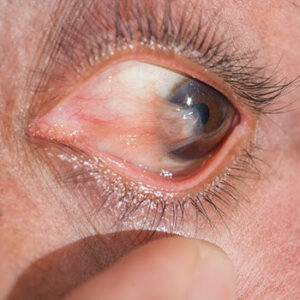Eye Conditions
Eye Conditions We See At The Clinic
Astigmatism
Astigmatism, as scary as it sounds, is not a disease but a refractive error, like nearsightedness or farsightedness. Symptoms include blurry vision at all distances, squinting, headaches and in children, if left untreated, amblyopia (lazy eye). While the lenses required to compensate for nearsighted and farsighted vision need only one power in the lens (a sphere) astigmatism needs 2 (think of a football or a soda can). In addition, these 2 powers can be oriented horizontally and vertically or any place in between.
Since we rely on donated glasses for our clinics, finding a prescription with the proper powers AND orientation can be a challenge. We routinely have lenses with smaller amounts of astigmatism, but for larger amounts (especially for children and adults with high visual demands) we try to make custom glasses at home. We then find a courier to take the glasses to the patient. This process can take months.
(From Julie Ensinger, OD and Jen Jacobs, OD )
 Pterygium
Pterygium
A pterygium (in Spanish, “carnosidad de ojo”) is one of the most common conditions we see in our I Care clinics. It is an overgrowth of conjunctival tissue onto the cornea that can be sight-threatening as well as uncomfortable, dry, and itchy. Pterygia are caused by long-term exposure to sun and wind. The best treatment for this condition is prevention which is why we try to have enough high-quality UV-blocking sunglasses for everyone who comes to the clinic. We also distribute artificial tears and instructions for making an eye wash from readily available chamomile tea when the drops are gone.
(From Julie Ensinger, OD and Jen Jacobs, OD )
 Cataracts
Cataracts
Cataracts (in Spanish, “cataratas”) are the most common cause of blindness worldwide according to the CDC. Cataracts are caused by the breakdown of proteins in the lens of the eye causing the once clear structure to become cloudy and eventually, if left untreated, opaque. They usually develop slowly over time due to aging and ultraviolet light exposure. They can also be caused by diabetes, injury, or certain drugs. Most people will have some cloudiness of the lens by the time they reach 60, although it may be many more years before their vision is affected to the point of needing surgery. Cataracts are treated by surgically removing the cloudy lens and replacing it with a clear, plastic one. While we will all develop cataracts as we age, protecting our eyes from sunlight, not smoking, and eating a healthy diet can help slow the progression of cataracts.
In our I Care International clinics that take place in areas closer to the equator, we encounter many patients with cataracts even at younger ages due to the more intense ultraviolet light exposure from people spending more time outdoors without sun protection. Some of these patients may be helped with eyeglass lenses but many need surgery. I Care International provides our patients with UV-blocking sun wear, education, and a referral for surgery when it becomes necessary.
(From Julie Ensinger, OD and Jen Jacobs, OD )
